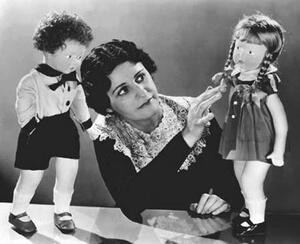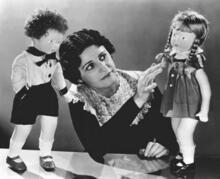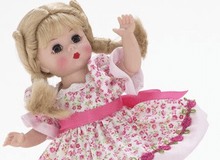Beatrice Alexander
Born in 1895 to Russian immigrant parents, Beatrice Alexander grew up watching her father repair dolls in his shop, the first "doll hospital" in the country. She began making her own dolls during World War I, when there was a shortage of imported dolls. By the 1930s, having obtained a loan to grow her business, she began making dolls with lifelike detail. Demand increased through the 1940s, as Alexander obtained trademarks for well-known figures such as Scarlett O’Hara and Jacqueline Kennedy. Through the mid- to late-twentieth century the company was honored with many awards and was commissioned to make dolls of the British queen and her daughters. Alexander was also a devoted philanthropist and a committed Zionist, serving as vice president of the Women’s League for Israel.
Best known as Madame Alexander, Beatrice Alexander became acquainted with doll making while watching her father repair dolls in his shop. She observed at an early age how important dolls were to children, and how often the poorly made or fragile dolls were impossible to mend. It was in her father’s doll hospital, the first of its kind in the United States, that Alexander learned her craft. Beatrice Alexander established her doll business in her home in 1923, and since then the Madame Alexander Doll Company has created more than 5,000 different dolls. Employing more than 650 people at its factory in Harlem, New York, the Alexander Doll Company is one of the largest doll manufacturing companies in the United States. Alexander believed that dolls play a vital educational role in a child’s early development, and thus she created doll collections based on historic events, literature, music, art, and film. Madame Alexander Dolls, as they are called, are on permanent display at the Smithsonian Institution, the Brooklyn Children’s Museum, the New Delhi Museum, and other museums worldwide.
Early Life and Dollmaking
Beatrice Alexander was born in New York City in 1895 to Russian immigrant parents. At the suggestion of her mother, she began to make dolls during World War I. The decrease in imported dolls created a shortage, and young Beatrice felt sympathy for children whose dolls could not be repaired or replaced. Her first project was the “Red Cross Nurse” rag doll with innovative, hand-painted, three-dimensional facial features. In 1923, she began to sell the dolls she had made on her kitchen table. By the late 1920s, she obtained a $5,000 loan to move her operations to a shop area. In the 1930s she began making dolls with lifelike details.
Alexander Doll Company
During this same period, the Alexander Doll Company obtained the trademark for a cloth Alice in Wonderland doll, a cloth series of Little Women characters, and a cloth series based on characters from Dickens’s novels. A turning point for the Alexander Doll company came in 1935, when the Canadian government granted the doll manufacturer the license to make Dionne Quintuplet dolls. The success of these dolls provided financial stability for the company and encouraged expansion. With the invention of synthetics in the 1940s, Alexander changed her materials to plastic and created dolls with vinyl heads and hair that could be styled. The demand for these dolls increased. Alexander obtained trademarks for well-known characters and public figures such as Scarlett O’Hara, Margaret O’Brien, Jacqueline Kennedy, Coco Chanel, Marlo Thomas, and various Disney characters.
During the period 1951–1954, the Alexander Doll Company was honored with the Fashion Academy Gold Medal. Also during this period, the British government requested dolls of the queen and her daughters. The 1953 coronation was reproduced in a set of thirty-six dolls dressed in exact detail copies of the royal family and honored guests, including Winston Churchill. This unique collection, valued then at $25,000, was donated to the Brooklyn Children’s Museum.
In 1965, the Alexander Doll Company was honored by Ambassador Arthur Goldberg for its International Collection of United Nations Dolls. In 1968, the Smithsonian chose for its collection the “Madame Doll,” representing the Revolutionary War, and the “Scarlett O’Hara” doll, based on the Civil War saga. Alexander dolls have received numerous awards from the doll industry, including the Doll of the Year Award (DOTY). In 1986, Madame Alexander was honored with the DOTY Lifetime Achievement Award.
Philanthropy
Madame Alexander was also known for her philanthropic activities, which included work for B’nai B’rith, the Weizmann Institute, Harvard University, and the Massachusetts Institute of Technology. She was a devoted Zionist and was a charter member of the Women’s League for Israel, which establishes homes for immigrants and disadvantaged youth in Israel. She served as vice president and was elected to the council of trustees of that organization. A rose garden was dedicated in her name at one of the league’s homes in Jerusalem.
Family
Beatrice Alexander was the wife of Phillip Behrman, with whom she had a daughter, Mildred. Mildred grew up in the business, as did her son, William Alexander Birnbaum. Although the company was sold in 1988, William Birnbaum remained president until 1994. Beatrice Alexander died at age ninety-five on October 3, 1990.
Obituary. NYTimes, October 5, 1990.
Press package, Madame Alexander Doll Company, NYC.





